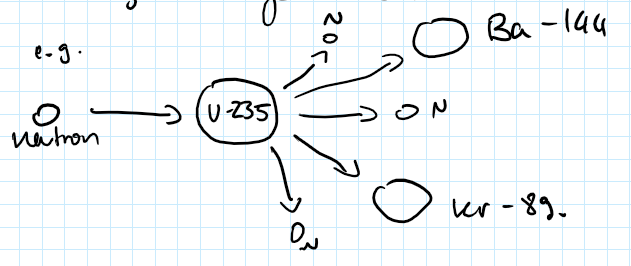(c) fission and fusion
1/6
Earn XP
Description and Tags
Name | Mastery | Learn | Test | Matching | Spaced |
|---|
No study sessions yet.
7 Terms
nuclear reactions are sources of .? (7.17)
energy
explain nuclear fission (7.18 / 7.19 / 7.20)
fission is the splitting of a large, unstable nucleus into two smaller nuclei
a neutron collides with the unstable nucleus
these are the reactants
and the nucleus splits into two daughter nuclei and two or three neutrons
these are the products
the neutrons then go on to collide with other unstable nuclei which splits into more neutrons which collide with more nuclei etc.
gamma rays are also emitted
this releases kinetic energy

use of control rods and the moderator during the fission process (7.21)
control rods:
made of boron or cadmium
absorbs neutrons
completely removes them from fission process
this helps to adjust the rate of fission in the reactor
moderator:
made of something like graphite
absorbs some of the kinetic energy of the neutrons to slow them down because slower neutrons are more easily absorbed by uranium 235 nuclei
role of shielding around a nuclear reactor (7.22)
the vessel is made of steel and surrounding by a 5m layer of concrete, meaning no radiation escapes
explain nuclear fusion (7.24)
the creation of larger nuclei resulting in a loss of mass from smaller nuclei, accompanied by a release of energy
differences between fission and fusion (7.23 / 7.26)
fusion: two light nuclei join to form a heavier nucleus
fission: a neutron collides with a large and unstable nucleus, sending out daughter nuclei, a few electrons, gamma rays. this has to happen under intense pressure and very high temperatures to force the nuclei together, since nuclei are positive particles and like charges repel, meaning than a lot of energy is needed to overcome the electrostatic repulsion
fusion is the energy source for..? (7.25)
stars